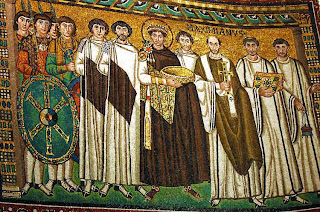Grade 8 Mosaic Field Trip (Kalemegdan Fortress - St. Petka Chapel)
1. Describe the mosaic you have chosen and include details about figures, colors, clothing, objects, etc.
What message is the mosaic trying to convey?
2. Compare your chosen mosaic to our checklist. Is it a good example of Byzantine Art? Why/not?
In St. Petka I saw pictures of eagle bodies with a realistic face, a lot of environment, nature, a lot of saints, Jesus Christ, angles, jewelry, mosaics, icons, new born babies, symbols, lots of color, leaders, repeating drawings, a king holding a castle, birds (freedom), floating feet, the more important person centered or closer, long dresses, all done in tiles, a lot of gold colored, feathers surrounding pictures, showing god many times and floating feet.
1.In the St. Petka Chapel, I chose the Angles. I think that angles are very unique. The angles in the chapel could mean a new born baby, bishops or even messengers. The color of the angles were white. Showing peace and freedom. There were two angles. One on each side of the baby. The figures shown in this mosaic I chose was that the baby was on a huge chair. Maybe showing that the new born baby was really important and could of been Jesus Christ. The angles were placed so they were facing the new born baby.
2. I think that if I compare the mosaic I chose to the Byzantine Art checklist it is a good example because the angles were turned in a meaningful gesture to face the new born baby, they had their feet floating and the huge chair that the baby was sitting on was symbolic, showing that the baby is someone really important. The scale that the mosaic placed is interesting because the baby is in the center showing the importance and the two angles are on each side floating. The angles our wearing white, so it is kind of shinning out and showing peace. The story seems really clear to me and is a good example of Byzantine Art.
1. Describe the mosaic you have chosen and include details about figures, colors, clothing, objects, etc.
What message is the mosaic trying to convey?
2. Compare your chosen mosaic to our checklist. Is it a good example of Byzantine Art? Why/not?
In St. Petka I saw pictures of eagle bodies with a realistic face, a lot of environment, nature, a lot of saints, Jesus Christ, angles, jewelry, mosaics, icons, new born babies, symbols, lots of color, leaders, repeating drawings, a king holding a castle, birds (freedom), floating feet, the more important person centered or closer, long dresses, all done in tiles, a lot of gold colored, feathers surrounding pictures, showing god many times and floating feet.
1.In the St. Petka Chapel, I chose the Angles. I think that angles are very unique. The angles in the chapel could mean a new born baby, bishops or even messengers. The color of the angles were white. Showing peace and freedom. There were two angles. One on each side of the baby. The figures shown in this mosaic I chose was that the baby was on a huge chair. Maybe showing that the new born baby was really important and could of been Jesus Christ. The angles were placed so they were facing the new born baby.
2. I think that if I compare the mosaic I chose to the Byzantine Art checklist it is a good example because the angles were turned in a meaningful gesture to face the new born baby, they had their feet floating and the huge chair that the baby was sitting on was symbolic, showing that the baby is someone really important. The scale that the mosaic placed is interesting because the baby is in the center showing the importance and the two angles are on each side floating. The angles our wearing white, so it is kind of shinning out and showing peace. The story seems really clear to me and is a good example of Byzantine Art.
St. Petka Chapel, Belgrade, Serbia




